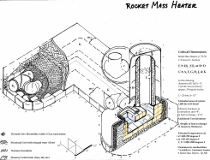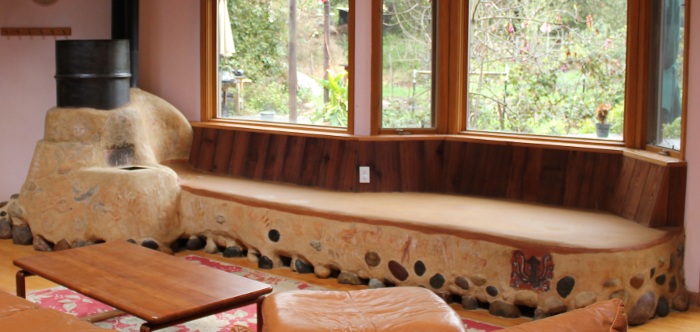wood stoves 2.0 can be ...
- rocket mass heaters
- double chamber cob ovens
- rocket stoves
- rumford fireplaces
rocket mass heaters
- heat your home with 80% to 90% less wood
- exhaust is nearly pure steam and CO2 (a little smoke at the beginning)
- the heat from one fire can last for days
- you can build a wood burning stove in a day and half
- folks have built them spending less than $20
A rich article with dozens of pictures and videos: rocket stove mass heater.





The first DVD, "Fire Science", gives the background information needed for rocket stoves and rocket mass heaters. The second DVD is "Sneaky Heat" referring to rocket mass heaters. The third DVD, "Boom Squish" is about rocket hot water and the last DVD, "Hot Rocket" is about rocket stoves, fox stoves, pocket rockets, and a rocket forge.
Wood Burning Stoves 2.0 4-DVD Set
The leading innovators today on rocket mass heaters are Ernie and Erica Wisner. They have built over 700 rocket mass heaters and their recent designs are superior to the designs of systems five to ten years ago. They are the moderators for the wood burning stoves forum. These are their recent designs:
Check out all of the wood burning stoves offerings from Ernie and Erica.
double chamber cob oven
Relevant discussion in the wood burning stoves forum:
rocket stoves

A rocket stove is the predecessor to the rocket mass heater and is designed for cooking food. They are for outdoor use only, although folks in some third world countries use them indoors because they are so much cleaner and more efficient than what they used before.
Erica Wisner has created an interesting rocket stove that looks a bit like a stump.
A thread in the wood burning stoves forum has a lot of pictures of different types of wood burning rocket stoves: a whole lot of rocket cook stoves





A lot of commercial rocket stoves are starting to come onto the market and they all seem to be missing parts that seem pretty essential to me. And then I heard about the kelly kettle - this seems to be an actual innovative improvement over all the others: the kelly kettle The idea is that the water sits inside the heat riser. I've seen these in use, and they boil water very fast with just a couple of twigs.
rumford fireplace
Thanks to Erica Wisner for use of these images. She has a massive page on this topic called fire science.










